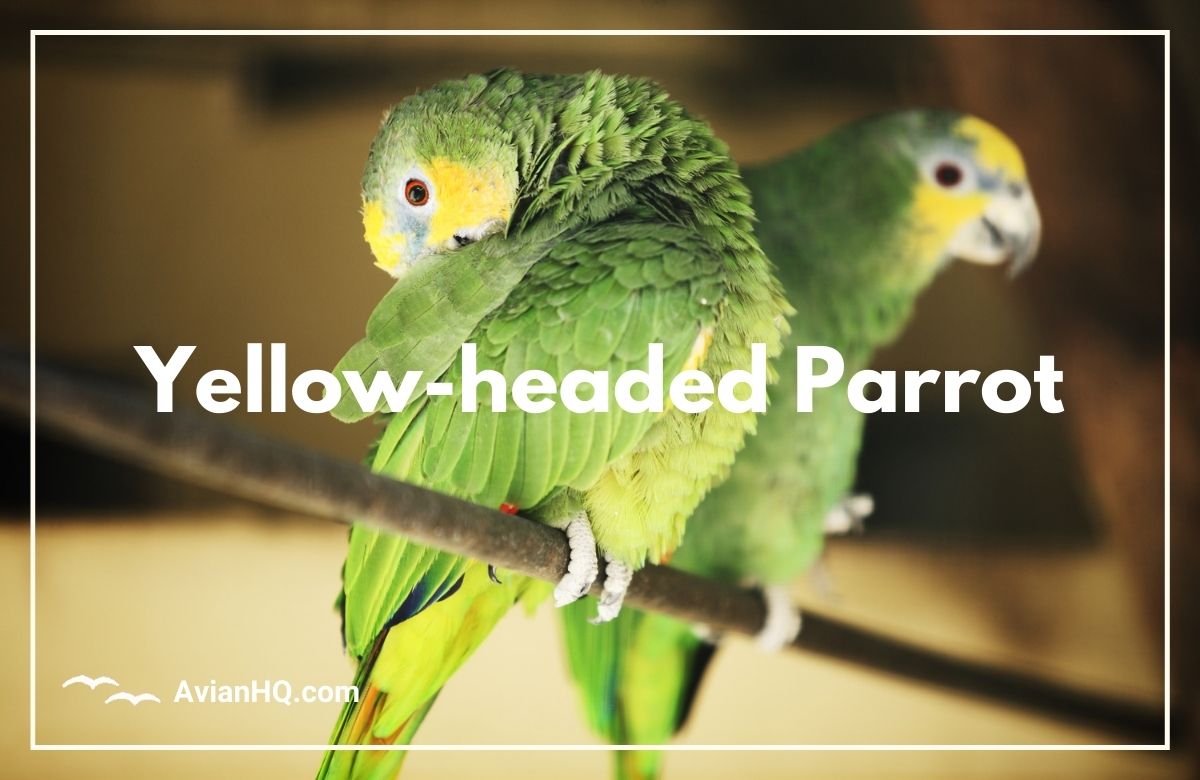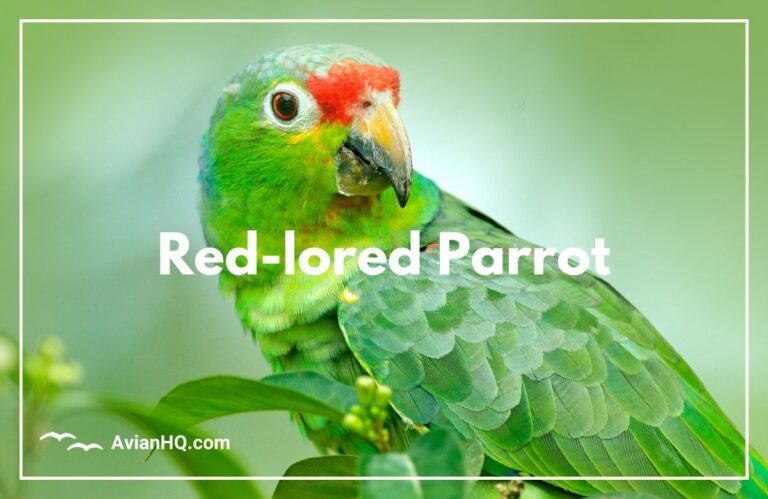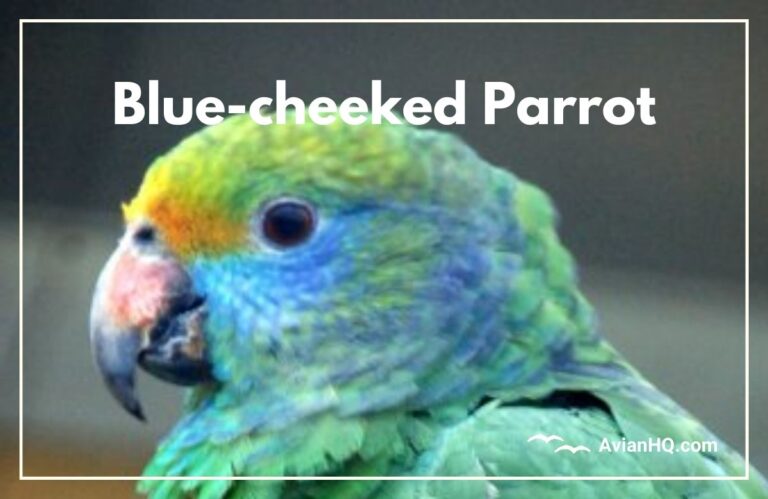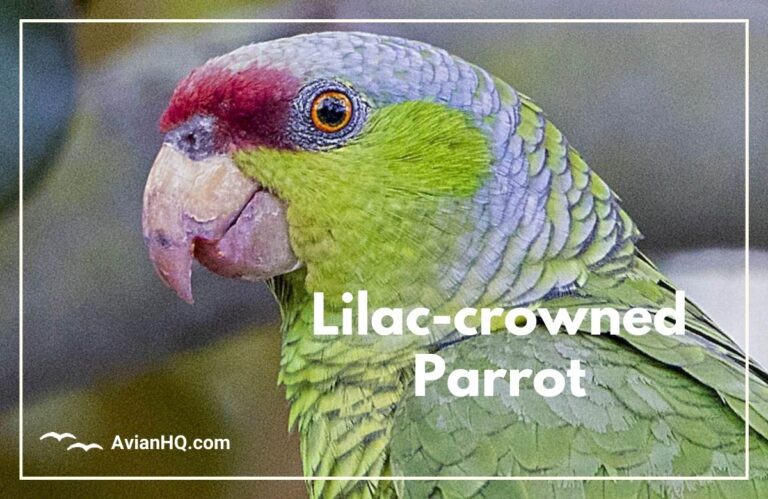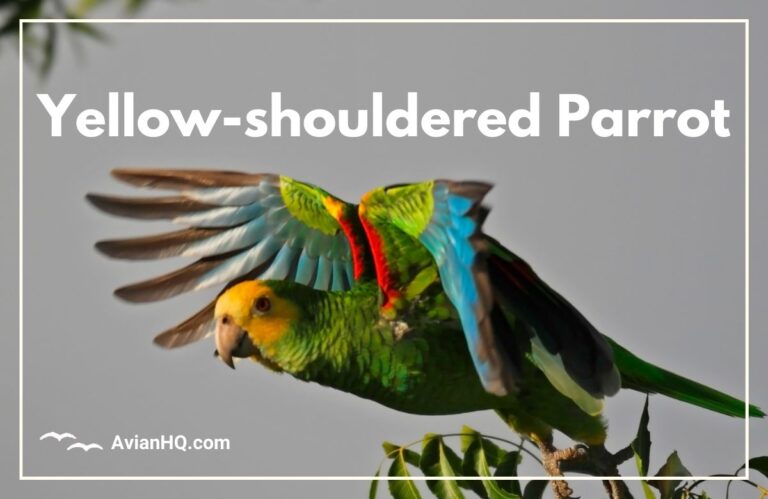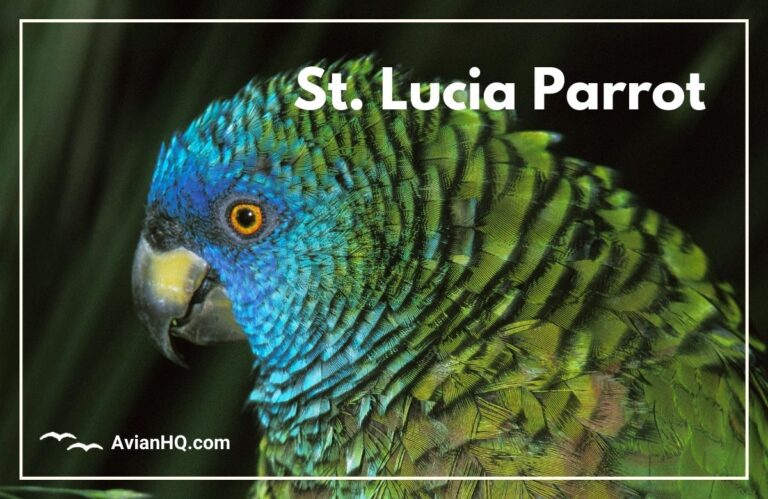Yellow-headed Parrot (Amazona oratrix)
Imagine encountering a vibrant parrot with a bright yellow head, red wing patches, and an orange eye peering at you as it flies among pine trees. If you were in parts of Mexico or Central America, you may have spotted the magnificent Yellow-headed Parrot (Amazona oratrix), one of the Amazon parrots famed for their beauty and intelligence.
“The yellow-headed parrot…is an endangered amazon parrot of Mexico and northern Central America.”
Reaching up to 15-17 inches (38-43 cm) long, these stocky green parrots live in small flocks among rivers and forests across parts of:
- Mexico
- Guatemala
- Belize
- Honduras
Prized as one of the best talking parrots, they have been popular pets for centuries. Their reputation as skilled mimics comes from a natural vocal ability. Wild yellow-headed parrots use a diversity of calls, from low croaking and screaming, to an almost human-like speech.
Sadly, extensive trapping of these birds for the pet trade is now threatening the species. Their numbers in the wild have dwindled by over 90% in recent decades. Habitat loss also jeopardizes their future. As few as 7,000 adults likely remain across their entire geographic range.
To save these declining parrots, conservation groups are working to crack down on illegal capture of wild birds. Public education aims to reduce demand for the Yellow-headed Parrot in the pet trade. Protecting existing habitat and nest sites gives hope that these magnificent parrots can rebound.
History and Taxonomy
The first known description of the Yellow-headed Amazon Parrot came from British zoologist Philip Lutley Sclater in 1859. He documented these parrots on the Tres Marias Islands off Mexico based on a specimen collected by explorer Auguste Sallé.
The species received its formal scientific name of Amazona oratrix in 1860 from American ornithologist George Newbold Lawrence. The genus name Amazona refers to New World parrots, while the specific name oratrix means “speaker” or “orator” in Latin. This highlights the Yellow-headed Parrot’s renowned vocal abilities.
Experts recognize 3-4 subspecies across the species’ range from Mexico down into northern Central America:
- A. o. oratrix – Occurs along Mexico’s Pacific and Gulf Coasts
- A. o. tresmariae – Endemic to the Tres Marias Islands
- A. o. belizensis – Lives along coastal and inland Belize
- A. o. hondurensis – Recently described subspecies in Honduras
The amount of yellow colored feathers on the head and neck helps distinguish these subspecies. The Tres Marias race shows the most extensive yellow.
Centuries ago, the Maya and Aztec civilizations likely kept Yellow-headed Parrots as pets. The species has a long captivity history, which unfortunately accelerated illegal trade leading to today’s endangered status.
Physical Appearance
The Yellow-headed Parrot has a total body length of 15-17 inches (38-43 cm) and weighs 10.5-14 ounces (300-400 grams). Both sexes share similar vibrant plumage.
Overall bright green in color, Yellow-headed Parrots get their common name from the bright yellow feathers covering the forehead, crown, cheeks, and throat. Some yellow feathers may also occur on the neck and upper chest depending on the subspecies.
Distinctive red feathers shine on the bend of the wings. The outer wing flight feathers and tail feathers are tinted dark blue or violet. Yellow also flanks the thighs.
The amount of colorful yellow head feathers helps distinguish the four subspecies:
- A. o. oratrix – Yellow on forehead, crown, cheeks, throat
- A. o. tresmariae – Most extensive yellow from forehead to upper chest
- A. o. belizensis – Yellow restricted to just the crown
- A. o. hondurensis – Yellow on crown and nape
In both sexes, the eyes are orange and surrounded by a prominent white or grayish eye ring. The stout bill ranges from light gray to horn-colored, often darker in young birds. Legs and feet span a variety of flesh, orange, or grayish tones.
Habitat and Distribution
The Yellow-headed Parrot occupies a variety of forested and wooded habitats across it’s native range from Mexico down into northern Central America at elevations from sea level to 5,200 feet (1,600 m).
They frequent diverse environments including:
- Riparian forests along rivers and streams
- Coastal mangrove swamps
- Deciduous and evergreen woodlands
- Pine and oak savannas and forests
- Semi-arid scrublands with scattered trees
- Areas of human cultivation with trees
This species formerly ranged across both the Caribbean and Pacific versants of Mexico. Their distribution reaches inland to parts of Guatemala, Belize, and the Atlantic slopes of Honduras.
In recent decades, habitat loss and trapping have extirpated some populations and significantly reduced their numbers and range. For example, along Mexico’s Pacific coastline, Yellow-headed Parrots now occupy less than 20% of their former habitat.
Beyond the native geographic range, small introduced populations have become established in a few areas, including:
- Southern California and Puerto Rico
- Stuttgart, Germany
- Sydney, Australia
These naturalized populations likely stemmed from escaped pet birds.
Diet and Feeding
Yellow-headed Parrots are primarily herbivorous, feeding on a variety of plant foods like:
- Fruit
- Seeds
- Nuts
- Leaf buds
- Blossoms
- Berries
Favored fruits include figs, palm fruits, and pods from acacia trees. These parrots sometimes also sample cultivated crops like corn and macuna beans.
Feeding activity usually takes place in small groups or pairs moving among food sources across their home range. During seasons when preferred foods become abundantly available, Yellow-headed Parrots may form large feeding flocks numbering into the hundreds of birds.
Communal roosting areas also draw bigger gatherings of these highly social parrots. They roost in cavities or crevices among high branches each night. Roost sites are typically situated near prime feeding grounds.
In the early morning hours, Yellow-headed Parrots leave the roost en masse. They then split into smaller subgroups to feed across the landscape through the day before returning to the night roost.
Breeding and Reproduction
The breeding habits of Yellow-headed Parrots remain somewhat poorly documented across their range. They likely do not follow a strict seasonal reproduction pattern, but can nest year-round based on food availability.
For nesting, pairs seek out holes in large tree cavities, especially older trees infected with heart rot that form natural hollows. Both sexes help select potential nest sites during courtship. The female then chooses among potential cavities. The male stands guard as she makes the final nest choice.
Clutch size ranges from 2-4 eggs which the female alone incubates over a period around 28 days. The male regularly feeds her during incubation shifts. The altricial chicks hatch with closed eyes and little feather coverage. After about two months, the young fledge from the nest. Parents continue supplement feeding fledged chicks for another month as they learn to forage on their own.
Some key facts about Yellow-headed Parrot breeding include:
- Year-round nesting capability
- Use large tree cavities for nest sites
- Clutch size of 2-4 white eggs
- 28 days incubation until hatching
- Chicks fledge at 8-10 weeks old
- Fledglings dependent on parents about 4 more weeks
Behavior and Ecology
The Yellow-headed Parrot is a highly social and vocal species often encountered in pairs or small groups foraging through the day. During certain seasons, hundreds of individuals congregate together into massive migratory flocks.
Their intelligence shows in a variety of interesting behaviors from raucous vocal displays to wood carving talents. Wild Yellow-headed Parrots utilize a diversity of loud vocalizations from screams to an almost human-like imitation speech. Their physical structure with strong jaws and beaks allows them to shred apart woody fruits and access seeds other birds can’t.
Some key aspects of their behavior and ecology include:
Social Structure
- Pairs/small groups of less than 20 birds
- Large communal roosts up to 100+ birds
- Mass migratory flocks of 200-300+
Communication
- Wide vocal repertoire – screams, speech-like sounds
- Mimic ability allows some simple speech
Feeding Habits
- Use strong jaws to open hard fruits/seeds
- Fly up to 12 miles daily between roost and feeding areas
- Raid cultivated fields for corn and other crops
Seasonal Movement
- Local migration patterns based on food availability
- Flocks show nomadic nature across the landscape
This unique parrot’s intelligence and social bonds shine through in their behaviors. However, the same traits that make them outstanding pets have fueled illegal trade decimating wild populations.
Conservation Status
The extensive decline of Yellow-headed Parrots across their native range has conservation groups gravely concerned about the species’ future survival.
The parrot is currently classified as Endangered on the IUCN Red List. Scientists estimate their total global population has dwindled to about 7,000 individuals as of 1994 surveys. This likely represents only 3,000-5,000 mature adults remaining in the wild.
Major threats fueling their endangered status include:
- Habitat Loss: Deforestation for logging and land conversion has destroyed much nesting and foraging habitat.
- Illegal Wild-Caught Pet Trade: Trapping for the pet trade removes up to 1,000 wild parrots per year by some estimates, decimating populations.
- Persecution as Crop Pests: Hunters shoot Yellow-headed Parrots raiding cultivated fields, further reducing numbers.
Targeted conservation efforts aim to curb declining populations including:
- Nest protection programs guard wild nest cavities from poaching.
- Anti-poaching enforcement tries to limit illegal capture for the pet trade.
- Environmental education programs reduce demand for wild-caught parrots.
- Habitat conservation through parks and reserves protect key breeding areas.
Time will tell if these interventions can pull the Yellow-headed Parrot back from the brink extinction as their future currently remains perilous.
Cultural Significance
The Yellow-headed Parrot holds a special spot in human culture, especially throughout it’s native range in Mexico and Central America.
- Indigenous peoples like the Aztec and Maya featured these parrots in cultural stories, legends, and artwork. Ancient pet keeping traditions likely began with native civilizations.
- This parrot’s beauty and renowned ability to mimic speech has made it an extremely popular aviary bird for centuries. Their prominence in the pet trade ultimately led to the species becoming endangered.
- Beyond speaking ability and colorful plumage, the Yellow-headed Parrot shows an intelligence allowing them to form social bonds with people. Anecdotes exist of them defending owners from harm.
- The species stands as the national bird of Honduras, adorning the nation’s coat of arms and currency. This represents their cultural pride, but also the peril they face today.
- Conservation breeding centers across North America and elsewhere work to preserve Yellow-headed Parrot genetic lines amid declining wild populations.
The outsized role this parrot plays in human society has unfortunately brought trouble for the species. However, many people today work to reverse the plight of this important cultural bird.
Conclusion
The vibrant Yellow-headed Parrot has long dazzled people with its beauty, intelligence, and speaking skills. Yet our fascination with this species as pets has led it down a dangerous path towards extinction.
As few as 7,000 Yellow-headed Parrots likely persist across Mexico and Central America. Deforestation and extensive poaching to supply the wild-caught pet trade now threaten the species’ survival. Without intervention, these brilliant green parrots with flashy yellow and red accents could soon disappear from tropical forests they have inhabited for millennia.
Conservationists have achieved success reintroducing captive-bred Yellow-headed Parrots at some sites after habitat protection. Anti-poaching efforts also aim to halt the rampant black-market pet trade devastating their populations.
Public support helps the cause by avoiding purchase of wild-caught parrots. Instead, consider adoption of the many homeless parrots already desperate for new homes after outliving their owners.
In the end, our conscience as parrot lovers should guide us to provide good welfare for our feathered companions while also securing the future for their wild kin. With commitment from governments, scientists, and the public, the outlook for these remaining “orators of the forest” can still regain it’s voice.

